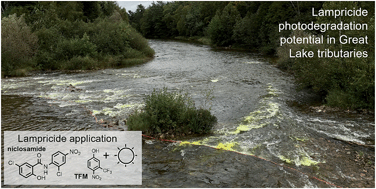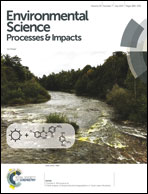A field analysis of lampricide photodegradation in Great Lakes tributaries†
Abstract
The lampricides 3-trifluoromethyl-4-nitrophenol (TFM) and 2′,5-dichloro-4′-nitrosalicylanilide (niclosamide) are added to Great Lakes tributaries to target the sea lamprey, an invasive parasitic fish. This study examines the photochemical behavior of the lampricides in Carpenter Creek, Sullivan Creek, and the Manistique River. The observed loss of TFM in Carpenter and Sullivan Creeks (i.e., 34 and 19%) was similar to the loss of bromide in parallel time of passage studies (i.e., 30 and 29%), demonstrating that TFM photodegradation was minimal in both tributaries during the lampricide application. Furthermore, the absence of inorganic and organic photoproducts in the Manistique River demonstrates that TFM and niclosamide photodegradation was minimal in this large tributary, despite its long residence time (i.e., 3.3 days). Kinetic modeling was used to identify environmental variables primarily responsible for the limited photodegradation of TFM in the field compared to estimates from laboratory data. This analysis demonstrates that the lack of TFM photodegradation was attributable to the short residence times in Carpenter and Sullivan Creeks, while depth, time of year, time of day, and cloud cover influenced photochemical fate in the Manistique River. The modeling approach was extended to assess how many of the 140 United States tributaries treated with lampricides in 2015 and 2016 were amenable to TFM photolysis. While >50% removal of TFM due to photolysis could occur in 13 long and shallow tributaries, in most systems lampricides will reach the Great Lakes untransformed.

- This article is part of the themed collections: Celebrating Excellence in Research: 100 Women of Chemistry and Editor’s Choice: Aquatic Photochemistry


 Please wait while we load your content...
Please wait while we load your content...